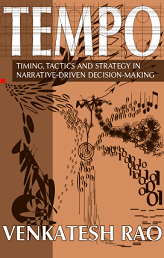This is a guest post by Mike Travers, who develops software at Collaborative Drug Discovery, blogs on diverse topics at Omniorthogonal, collects his random hacks at Hyperphor, and has a PhD in Media Arts and Sciences.
The scientific picture of the world has some disturbing implications when its assumptions are worked out to their ultimate conclusions. Brains and bodies are pieces of machinery subject to the laws of physics, and If we are simply mechanisms, then our ability to be free seems to disappear, along many of the basic foundations of everyday cognition and action (choices, selves, values, morality, consciousness, etc). The scientific worldview has proven both extraordinarily powerful and immensely unsatisfactory, given how at odds it is with our everyday experience. The disjunction between scientific thought and traditional humanistic thought was captured by CP Snow’s Two Cultures in 1959 but has only gotten worse since then. As a scientifically trained person who has worked on the margins of artificial intelligence, I’ve always struggled for ways to reconcile these two worldviews.




